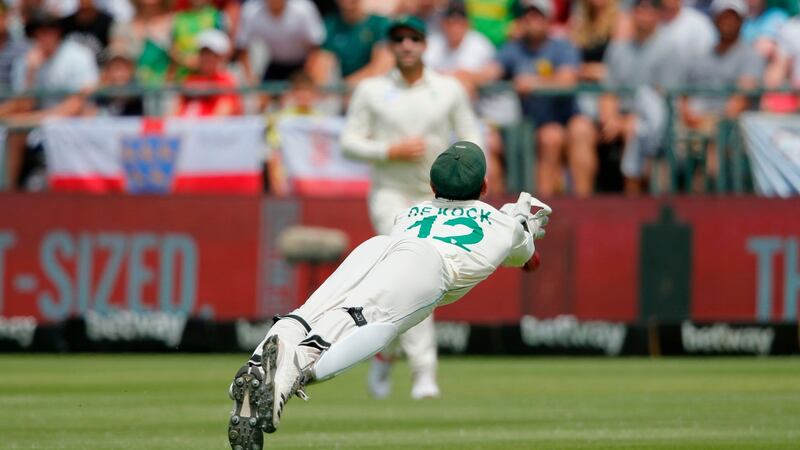Day 4 of 5: England 269 (O Pope 61no, B Stokes 47; K Rabada 3-68) & 391-8 dec (D Sibley 133no, B Stokes 72, J Root 61; A Nortje 3-61) lead South Africa 223 (D Elgar 88, H E van der Dussen 68; J Anderson 5-40) & 126-2 (P Malan 63no, D Elgar 34) by 312 runs.
The bandwagon for four-day Tests lost a wheel at Newlands. Here the game has already captivated busy stands for four fluctuating days and on the fifth a good number will surely turn up to witness the outcome of an intriguing contest.
All four results remains possible. At the close South Africa, who were set 438 to win from 146 overs, a required rate of exactly three runs per over, were 126 for two. The short odds are on an England victory and the draw but the last year in cricket has reminded us that anything is possible.
The pitch, an excellent one for Test cricket, has obstinately declined to deteriorate. In fact batting seems to be getting easier as was demonstrated by Ben Stokes and Dominic Sibley, who registered his maiden Test century in the first part of the day, and the South Africa top order in the evening, among whom was the veteran debutant Pieter Malan, who calmly reached his first half-century at this level.
South Africa have only lost against Australia in Cape Town since unification and there is no guarantee this proud record will be dented, such was the composure of Malan, in particular, on a surface that is taking a prolonged siesta. That much-discussed crack just outside of the right-handers’ off stump when the bowling is from the Wynberg End does not seem to be causing much havoc and the ball has turned significantly only when landing in the bowlers’ footmarks, which is not much help to Dom Bess.
Hence England, compelled to play an attack lacking express pace, have toiled dutifully for 56 overs with modest rewards. In fact the first wicket to fall was a collector's piece and a source of some controversy. On 34 Dean Elgar became Joe Denly's first Test wicket.
Until this match Denly had propelled 40 overs of his wrist-spin in Test cricket, yielding 148 runs and no victims. Here Root turned to him just before tea primarily because the rough outside the off-stump of the left-handed Elgar was in play for Denly’s leg-break. Elgar was immediately troubled by the unpredictable bounce when Denly was on target so it was not so surprising that Root persisted with him after tea.

In Denly's sixth over Elgar pushed forward; the ball ended in Jos Buttler's gloves and there was a concerted appeal for a catch. The umpire Paul Reiffel paused and then raised his finger. Immediately Elgar sought a review and an agonising wait for both sides ensued. There is no Hot Spot in use here so everything depended upon Ultra Edge, the snicko instrument used to detect nicks. This revealed the tiniest of tremors on the screen and therefore the decision of the on-field umpire was upheld. Elgar departed like a man betrayed.
England were jubilant but the less experienced South African batsmen at the top of the order remained steadfast. Malan gave the impression that he had been playing Test cricket for most of the last decade and Zubayr Hamza hung on for a while with less conviction.
Root shuffled his bowlers, all seven of them, which included himself. Stokes explored the middle of the pitch at around 90mph, which was a source of discomfort to Hamza in particular; Bess was steady rather than venomous; Denly was less threatening against the right-handers; the old guard probed expertly but the South Africans could trust the surface as well as their technique. However Jimmy Anderson, still full of vim, conjured the wicket of Hamza just before the close when an outside edge was deftly held by Buttler.
Even so, it was by now apparent that taking 10 wickets would be no picnic for England so it was just as well that they had batted so positively in the morning to give themselves more time in the field. At the start they immediately posted their intent with the bat, to be more precise the bat of Stokes, who sparkled.
South Africa declined to take the second new ball straight away partly because some of their quicker bowlers, though on the field, were ailing. Without delay Stokes treated Dwaine Pretorius to a conventional pull, a straight six and a reverse sweep; he deposited a blameless delivery from Keshav Maharaj into the stands at midwicket. In the meantime Sibley continued in the same vein as Sunday night.
The new ball was taken but Maharaj continued at one end for the rest of the England innings. A top edge off Kasigo Rabada escaped the fielders but otherwise Stokes’s hitting was awesomely assured. He raced to his half-century in 34 balls.
Meanwhile, Sibley looked on admiringly and in his steady way proceeded towards three figures. He reached his landmark with a sweep to the boundary off Maharaj from the 269th delivery he faced. He had been at the crease for almost seven hours when he became the first Englishman to score a century at Newlands since Jack Hobbs.
Seventy-four runs came in the first hour and then England accelerated via Stokes until he attempted one more six off Maharaj. This time the ball skimmed towards long-on where Rassie van der Dussen held the catch. This had been the carefree Stokes of old intimidating the bowlers and oblivious to his batting average while smashing 72 from 47 balls.
Ollie Pope was bowled off the inside edge, then there followed a cameo from Buttler who cracked two sixes in his innings of 23 from 18 balls. There were a few biffs from Curran, a rare not out for Broad and Sibley was still there unbeaten on 133 when Root declared. – Guardian



















